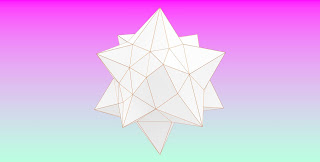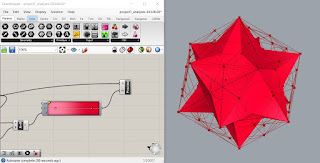The second iteration of Strange Habitat, Strange Habitats, pushes the initial icosahedron form to a dodecahedron form comprised of multiple icosahedrons. This form generation emerged during the first iteration, deconstructing the icosahedron boundary representation (BREP) and using its respective faces as mirror planes. Mirroring the icosahedron using its own faces as mirroring planes creates 20 (one for each face of the icosahedron) additional 20 icosahedrons, 21 including the original. These 20 new icosahedrons are then joined using a solid union, resulting in a closed polysurface around the original icosahedron. As previously mentioned, the new organization resembles a more complex dodecahedral form.
Strange Habitat (the first iteration) deconstructed the icosahedron BREP to host spheres to vertices and pipes to edges. Strange Habitats possesses that capability as well, while allowing adjustment to the sphere radius and using that same value to control the ratio of sphere radius to pipe radius.
Moving beyond using the deconstructed BREP to create potential elements for form and construction, this second iteration creates a mesh from BREP. This mesh can then be used in conjunction with various WeaverBird tools in order to change the form and articulation of the mesh. The mesh can construct the mesh with triangles, which can then be used with WeaverBird's window or frame (below) nodes to articulate the mesh. We can then give the frames form by using the thickness node.
WeaverBird also possesses a node that can render the mesh as a Sierpinski triangle pattern. Similar to the frame node, the Sierpinski node can be run through the thickness node. To further develop the mesh into form, the thickened Sierpinski triangle mesh is run through the stellate node. This node creates a pyramid (kis) on each mesh face.
While this project began referencing modular architectural design (Habitat '67, Nakagin Capsule Tower, etc.) and modular design installations (Pneuhaus and Foldhaus), the outputs more closely resemble the work of Yelena Filipchuk and Serge Beaulieu, which produce "large scale installations and artworks that investigate geometric exploration through light, shadow, and perception." under the name "Hybycozo". Future development of Strange Habitats could use daylighting simulation in order to adjust the scale of perforation in the mesh with respect to the desired amount of light for a specific geographic location and certain times of the year i.e. desiring more direct sunlight during colder months, and indirect sunlight during hotter months. We then may want to develop means to make the mesh operable, so that a single design could function parametrically as well as being designed parametrically.
References:
- Filipchuk, Yelena and Serge Beaulieu. Hybycozo. Accessed November 30, 2020. <https://www.hybycozo.com/>
- Foldhaus. “Radialumia” 2018. Accessed 26 Oct 2020. <https://www.foldhaus.com/radialumia>
- Gili Merin. "AD Classics: Habitat 67 / Safdie Architects" 21 Jul 2013. ArchDaily. Accessed 26 Oct 2020. <https://www.archdaily.com/404803/ad-classics-habitat-67-moshe-safdie> ISSN 0719-8884
- Megan Sveiven. "AD Classics: Nakagin Capsule Tower / Kisho Kurokawa" 09 Feb 2011. ArchDaily. Accessed 26 Oct 2020. <https://www.archdaily.com/110745/ad-classics-nakagin-capsule-tower-kisho-kurokawa> ISSN 0719-8884
- Pneuhaus. “Pneumatic Masonry / Houston”. Pneuhaus. Accessed 26 Oct 2020. <http://pneu.haus/projects/pneumatic-masonry>


















